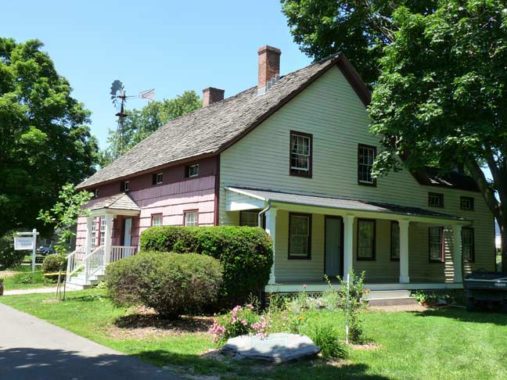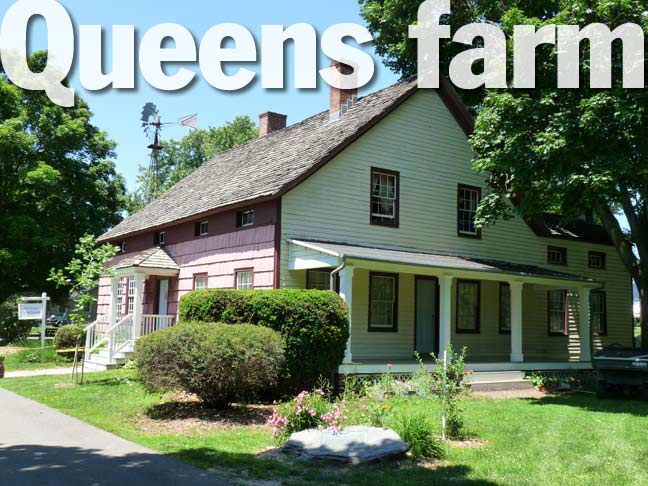I was stumped on what to write about — I’ve been lethargic today and even napped from 1 to 2 PM — so I decided to go back to June 2014 when I made one of my relatively few visits to the Queens Farm Museum, which is down the road from my home near the railroad tracks in Little Neck. It was a crystal clear day and the photos came out really well.
The Queens County Farm Museum, at Little Neck Parkway south of 73rd Road, occupies 47 acres in the heart of Glen Oaks, Queens, New York as the Agricultural Museum of New York: its croplands and orchards are being used to demonstrate the history of agriculture to students and visitors. The Museum staff and volunteers harvest apples and grow herbs, squash, tomatoes and other standard market vegetables, which are sold from a farm stand on the grounds on selected days during the week.

The Farm Museum holds educational tours and student workshops cover horticultural technology, farm life history and food preparation. You will find friendly cows, goats and sheep begging for handouts, which are provided to you, although there are signs telling you what not to feed them (as fruit tends to ferment in the ruminants’ multiple stomachs). The Museum is the staging area for several annual events, such old-fashioned county fairs, an annual Native American pow-wow and an antique car show. Consult the Museum’s events calendar for details.

The tract has been farmed for over 300 years. Earliest records show it being sold by John Harrison to Elbert Adriance in 1697; the farm stayed in the Adriance family until the early 1800s, and Elbert’s son Jacob constructed the present farmhouse in 1772.

The farm continued to thrive under the ownership of the Peter Cox family, who expanded the farmhouse to its current size, from 1833 to 1892. That year, Daniel Stattle purchased the 101-acre site from the Coxes for $20,000. By 1926, the State of New York had acquired the farm and used it to complete the Creedmoor Psychiatric Center, and the grounds were tilled in part by patients, for therapeutic purposes, for many years. In 1976 the farmhouse was designated by the NYC Landmarks Preservation Commission, and by 1982 the farm had come under the aegis of the New York City Department of Parks. Today it is managed by the Colonial Farmhouse Restoration Society of Bellerose.

The Jacob Adrience farmhouse was restored in 1986 to resemble its condition in 1856, when the Cox family last expanded it. Inside, you will find original plank floors, beamed ceilings, window glass and hardware. Of all of New York’s remaining 18th century buildings, this one may retain more of its original materials than the others.
Other farm buildings were all constructed after 1927 and include three greenhouses and a connecting potting shed, a wagon shed, two barns, garages and a brooder house.
A particular annual favorite is the Museum’s two Tavern Nights, held in November. Servers in period dress serve Revolutionary-era recipes by candlelight. Best to make your reservation now — these nights tend to be booked early. Also, oddly enough, the Farm Museum is popular for wedding receptions and photo opportunities.
Contact the Museum at (718) 347-3276, or consult the Queens Farm website.
Check out the ForgottenBook, take a look at the gift shop, and as always, “comment…as you see fit.”
2/22/19


6 comments
And the maze, don’t forget the maze.
Hi Kevin,
Being somewhat familiar with the farm, I’ve wondered if the driveway in front of the farmhouse is a remnant of the Black Stump road, which, as you have mentioned in a previous article, ran through Fresh Meadows along the route of present day 73rd Ave. If you look at a map, you will notice that if you run a line from 73rd, across the Cross Island Parkway, it lines up perfectly with the driveway that runs through the farm. I thought this might be possible, as the eastern end of Black Stump (73rd) seems to disappear in Alley Pond Park. Usually, farmhouses were built close to a main road. If you use your imagination, that driveway could have continued east as far as Union Turnpike. Otherwise, why wasn’t the farmhouse built closer to or on Little Neck Parkway?
What do you think?
Interesting
Of interest is this site: https://www.archives.nyc/blog/2019/8/16/the-queens-borough-president-panoramic-photographs . The 4th photo down, from 1931 shows LNP looking north just before Union Turnpike, thus thus the farm is in the distance, on the left (VBMPkwy overpass in the distance. I own the last of the 19th century Rhodes homes on the corner of 87th avenue and LNP, a large wooden frame farmhouse built in 1878, in my family since 1954..
IIRC, a teacher at Van Buren High School (Queens Village) was instrumental in the mid-to-late 1970s in cleaning up the farmhouse and grounds. They were overgrown and practically abandoned. Mr. Andorfer and his horticulture classes did the work.
I lived there as a caretaker in 1977 in the second-floor area which we made into a small living room, kitchen area and bedroom and bathroom. During one of the huge snowstorms in 1977 (?) the small
windows at the base of the sloped ceiling blew open and overnight that part of the room filled with snow. So aside from banging my head as I usually did from the angled ceiling as I got up for work, I found myself standing In about a foot of snow. In the basement (not sure whether under the current building or the portion of the building that was removed?) I found an old trash heap with multiple bottles and
artifacts. We excavated them and they were on display for a time – probably still are. There was a newspaper article at the time (Long Island Press?) about the discovery.
Remember Mr Andofer and his Horticulture class.